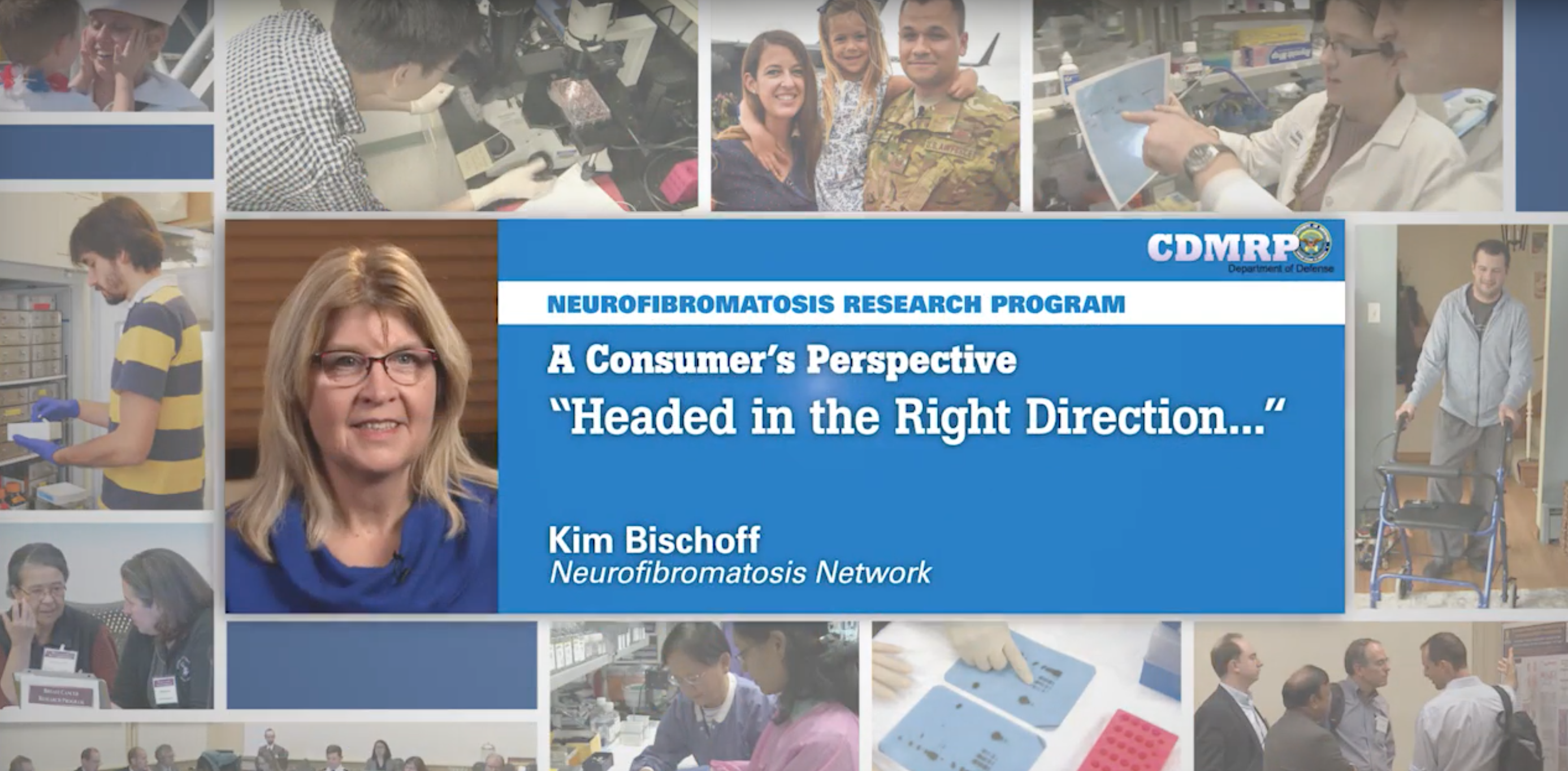A Consumer’s Perspective: “Headed in the Right Direction…”
Author: Consumer: Kim Bischoff; Neurofibromatosis Network
Published On: 10/01/2018

Kim Bischoff Video (CLICK HERE to watch video or read text version below)
2018 NFRP Vignette
Title: A Consumer’s Perspective: “Headed in the Right Direction…”
Consumer: Kim Bischoff; Neurofibromatosis Network
My name is Kim Bischoff. I’m the Executive Director of the Neurofibromatosis Network. But most importantly, I’m the mother of Jennifer, who is 34 years old, and she has neurofibromatosis type one.
When Jennifer was two-and-a-half-years old, we got the diagnosis of NF based on a growing optic glioma. She actually had one eye that was protruding than the other. We ended up traveling around the country trying to find out what to do with this growing optic glioma that hadn't hit the chiasm yet, but we needed treatment; otherwise, she was going to lose vision in both eyes. We were really fortunate to find the therapy. The therapy was very successful. The eye actually went back into the socket. She did lose the vision in her left eye. But it didn’t go back into the brain, and she’s doing very well now.
After our daughter’s diagnosis, we were looking for a patient advocacy organization. That’s when we landed with the NF Network, and we’ve been involved with that group for over 30 years now. It’s been a great source of support for our family and our daughter. Since my husband and I don’t have NF. This gives her a community that she can network in where there’s people that really understand the same issues that she’s going through. One of issues that she had struggled with was whether or not to have children. This community really provided her with the information she needed to make her own personal decision.
As an advocate, I have been involved in the DoD program since its inception for NF back in 1996. I have done peer review, and I have done the programmatic review for the last 8 years. NF is so fortunate to have this community of brilliant and dedicated scientists, researchers, the clinicians, all working together to try to find these treatments for my daughter and the other 100,000 individuals that have NF.
My experience as a peer reviewer has been amazing. As a non-scientist, when you first come in, you’re really intimidated. But they appreciate your position as a consumer. They welcome your input. It’s been absolutely phenomenal and really humbling when they listen to my ideas, my thoughts. They take them into consideration. It is truly what gives us hope for the future is this program and the work that’s being done. We feel very blessed and lucky to have NF in this program.
The programmatic review is really exciting because we have areas of emphasis. Once all of the excellent science comes up, we have the opportunity then to decide which programs fit best in those categories. Even if something maybe didn’t score quite as well as some of the others in science, but yet we really feel as a community, the scientists included, they feel like this is really something that we can do, we have the opportunity to fund. And I really think that sets us apart from any other kind of scientific review process. It gives us the flexibility to fund what we think is absolutely the most critical to in order to be able to help the community of neurofibromatosis.
The CDMRP NF Research Program has been huge. It’s not only helping people with NF, but others as well who have diseases and conditions that are located around that same pathway. I think that we’re really hitting the different areas that we need to in order to be able to attract excellent science into the field of neurofibromatosis.
Being able to treat optic gliomas like my daughter had back when we first came into the community is much more streamlined now. Families don’t go through quite the stress that we went through. It seems to be a pretty well-known practice on how to treat the children. Of course, we would like less toxic and better treatments for those particular manifestations of NF, but they’re clearly much improved than what they were in the past.
There are also other new treatments on the horizon here for the plexiform neurofibroma that’s showing great promise. I think that we’re headed in the right direction. We could use more. Clearly there’s things that need to be learned about when a regular tumor changes into a malignant tumor, but they’re all being worked on. So it’s just a matter of time. If we can keep doing this and getting the scientists the funding that they need in order to do the important work that they do, we’ll get to that endpoint.
Want to view archived newsletters? Click Here!
Newsletter
Sign up to receive the latest neurofibromatosis news and information in your inbox!
Subscribe